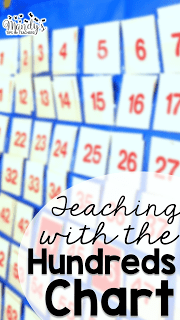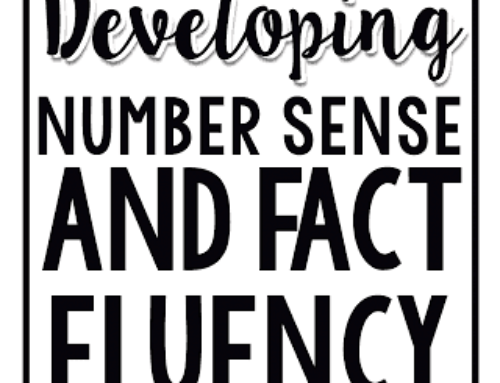Ya’ll. This is such an easy thing to use to build number sense. I taught fourth grade ELA for several years. Then, I moved down to second grade and had to teach all subject areas.
I knew I needed a hundreds chart because they are in all the primary classrooms, but I didn’t know what to do with it.
You count, right?
Um, yes, Mandy from 8 years ago, but you can use it for so much more.
So how can you use a hundreds chart as an EASY and fast way to build number sense? Check out these ideas!
Build the Hundreds Chart
Have you ever actually built the hundreds chart with students? This is a fantastic math lesson for the VERY beginning of the year in either first or second grade. It can be completed in several short spurts over the course of a few days, which makes it easy to squeeze in a meaningful math lesson during the back to school craziness.
I found TWO explicit FREE lesson plans one how to complete this lesson. One version of the lesson is for younger students and the other is for about second grade.
Another way to build the hundreds chart is to actually have students build the hundreds chart as puzzles!
As students become more familiar with the hundreds chart they can fill in the missing numbers on the chart.
Once students have mastered filling in a complete chart, challenge them to fill in missing pieces of the chart. This is a perfect independent activity during centers!
Build Number Sense
The hundreds chart is a perfect introduction to patterns in numbers and developing number sense. Some struggling learners (even in second grade) may struggle with before and after. To practice this, you can simply have kids come to the board to touch the numbers that become before or after a given number.
You can also display the hundreds board and divide the class into two lines to create a “relay race” of sorts. The two students at the front of the line will “race” each other to answer the questions (correctly) first. The student that answers first wins a point for his or her team. You can ask questions like, “What number comes before 18?” and “What number comes after 78?”
The hundreds chart is perfect for practicing skip counting. You can use it to model skip counting from a given number by 2, 5, or 10. Challenge kids by asking them to skip count by 5, from a number that does not end in 5 or 0, or skip count by 2 from an odd number! Don’t forget to practice skip counting by 25, which will lend itself to counting quarters when it is time to practice counting change.
Adding/ Subtracting Ten and One
In second grade, students have to be able to mentally add and subtract 10 in a given number 100-900. The hundreds chart and its set up are ideal for introducing this. It can be very difficult for students that struggle with place value, especially as you reach the higher 3 digit numbers. The hundreds chart is a perfect way to being teaching visual patterns in numbers.
For example, when adding one, the ones places increases by one. When subtracting one, the ones places decreases by one.
For example, when adding ten, the tens places increases by one. When subtracting ten, the tens places decreases by one.
An easy way to show this skill is to project the hundreds chart on your Smart of Promethean Board and use counters to actually move by ten spaces or one space. You can also just use an old fashioned hundreds chart that is a pocket chart, like I have pictured here.
Eventually after you have modeled this several time and related it to the number sentence (23-10 = 13), you can show a small zoomed in grid that looks like a plus sign. By learning patterns on the hundreds chart, they can easy (and visually) add and subtract ten and one to any given number.
Once students are comfortable with adding and subtracting with the hundreds chart, they can play a variety of games in their interactive math notebooks. Students can use counters instead of coloring on the game board to cover places on the hundreds chart, so they can play the games over and over!
Arrow Cards
Have you ever seen arrow cards? They are so cool!
It is a great way to encourage mental math skills in a different, more abstract format.
Teach students to mentally add and subtract 10 and 1 by using arrow cards. Give students a starting number. Then students will use the arrows to move across the hundreds chart to find the ending number. It can be hard to explain in writing. Here is a video, so you can see it in action.
If you are looking for any of the activities pictured above, they can be found in my Exploring the Hundreds Chart pack. You can see that here.
Do you have any additional ideas for the hundreds chart? There are a million ideas!
Click here for this great pack of FREE math centers, plus get tips and updates from me!
Mandy Gregory is a 2007 and 2012 Teacher of the Year. She has taught Kindergarten- 4th grades in both the general education and inclusion settings. She is currently a 1st grade Special Education teacher. She is the owner and creator of Mandy’s Tips for Teachers website (www.mandystipsforteachers.com) and has over 13 years of teaching experience. She is married with two beautiful children.


















Hey! It's a cool studying method! I am sure it works excellently. I will definitely take it into account. I know some students aren't really interested in the studying. They are more likely to miss classes, cheat on exams, apply to British essay writer service, ask their group mates to do their homework. I am sure such creative approaches will intrigue them and involve them in acdemic process. So, thank you again for the article..
I may just recommend you to use writing services and dont worry about it anymore. I use custom research paper
when I need the quality an essay, written by the professional writers and the price is very cheap. I am sure that for you it will be the best option.